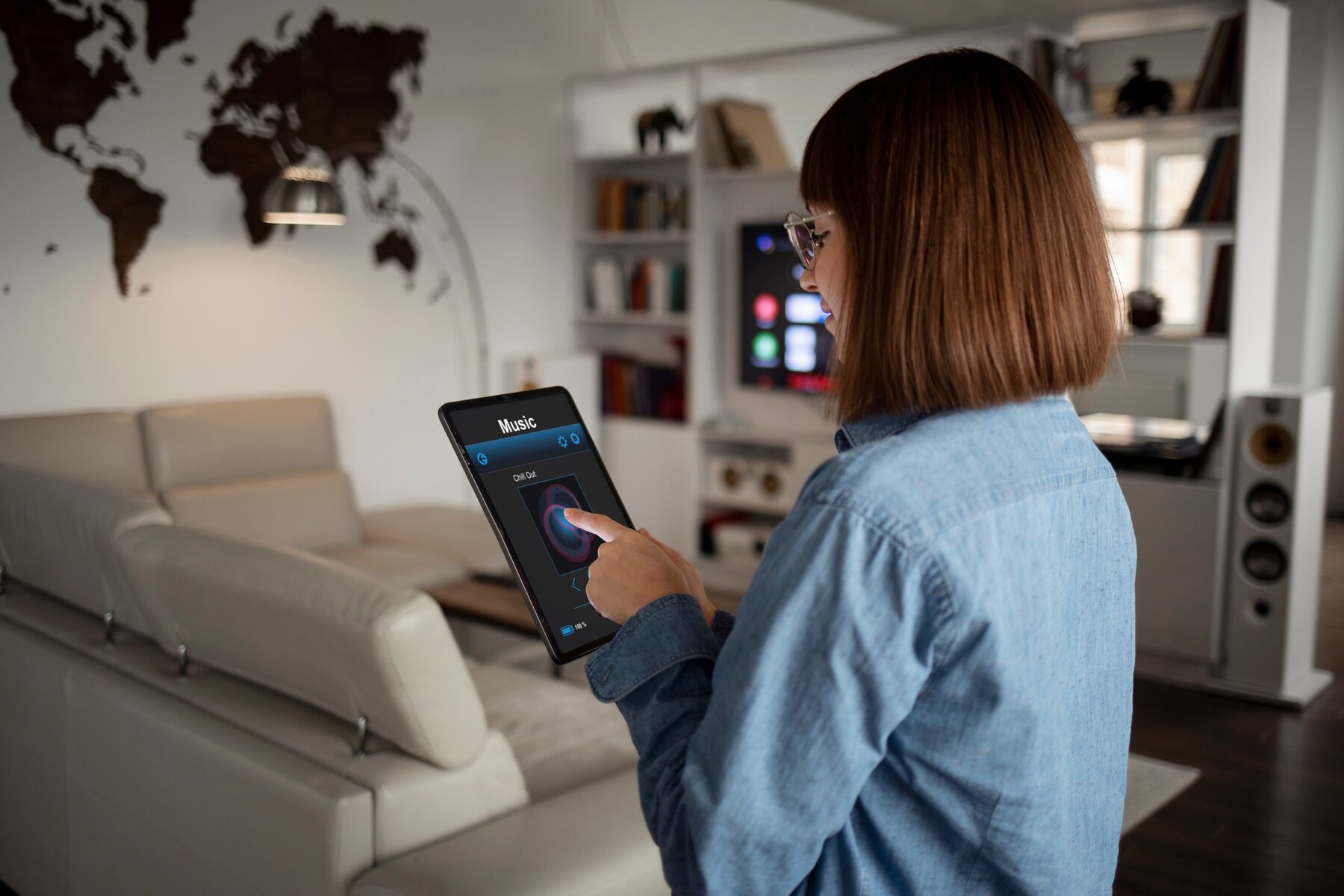
How to Use AI for Smart Home Automation and IoT Devices
Artificial Intelligence (AI) is now a key part of our daily lives. It is changing industries and how we use technology. One significant change is in smart homes and the Internet of Things (IoT). AI-powered IoT devices have made homes smarter. They improve convenience, security, and efficiency.
From voice assistants to self-learning thermostats, AI in smart homes is a reality for millions. This article explores how AI fuels innovation in smart homes. We’ll cover the best AI devices, the challenges of using AI, and the future of home automation.
Pro Tip
Invest in AI-powered IoT devices that support future upgrades and software updates to ensure long-term compatibility and enhanced functionality.
Quick Guide
- AI in Smart Homes: AI enhances automation, security, and energy efficiency.
- Key Devices: Smart speakers, AI-powered security cameras, robotic vacuums, and smart appliances.
- Benefits: Personalised experiences, predictive maintenance, and improved safety.
- Challenges: Privacy concerns, interoperability issues, and high initial costs.
- Future Trends: Context-aware automation, wearable integration, and advanced home robotics.
Important:
Ensuring robust cybersecurity measures is crucial as AI-powered IoT devices collect and process large amounts of personal data.
The Evolution of Smart Homes and IoT

The Early Days of Smart Homes
Home automation ideas have existed for decades. Early inventions included remote-controlled garage doors and heating systems. However, these systems required manual control and lacked intelligence. The rise of IoT changed everything by allowing devices to communicate and operate without human help.
The Role of IoT in Smart Homes
IoT connects devices that share data to provide automated services. Now, you can control smart thermostats, lights, security cameras, and appliances from your smartphone or even by voice. The real breakthrough is AI integration, which helps devices learn from user habits and make wise choices.
AI’s Impact on Smart Homes
With AI, smart home devices go beyond following commands. They can anticipate needs and improve efficiency. AI-driven IoT devices can:
- Learn and adapt to user habits
- Predict maintenance needs before issues arise
- Improve security with facial recognition and anomaly detection
- Cut energy use by optimising appliance operation
AI’s Role in Enhancing Smart Home Functionality

Personalised User Experiences
AI devices analyse user behaviour to create tailored experiences. For example:
- Smart thermostats, such as the Nest Learning Thermostat, learn your routine. They adjust the temperature to keep you comfortable and save energy.
- Philips Hue and other AI lighting systems change brightness and colours to match your preferences.
- Virtual assistants like Amazon Alexa and Google Assistant tailor their replies. They do this by using past interactions. So, they can suggest music, news, and shopping options.
Predictive Maintenance and Energy Management
AI IoT devices track performance and send alerts for maintenance. This helps cut repair costs and makes appliances last longer. Examples include:
- Smart refrigerators that spot food spoilage and alert users.
- AI-powered washing machines that optimise water and detergent use for better efficiency.
- Energy-monitoring systems that suggest ways to reduce electricity usage, leading to lower bills.
Enhanced Security Measures
AI-powered security systems improve home safety with features like:
- Facial recognition helps smart doorbells like Ring and Nest Hello tell apart family, guests, and intruders.
- Anomaly detection algorithms that spot suspicious activity and send alerts immediately.
- AI-driven robotic security, such as Amazon’s Astro, patrols and monitors for unusual behaviour.
AI-Powered IoT Devices Transforming Homes
Smart Speakers and Virtual Assistants
Devices like the Amazon Echo and Google Nest Hub act as hubs, connecting various smart devices into one network. These assistants:
- Answer questions and provide real-time info
- Control smart devices with voice commands
- Manage schedules and reminders
- Help with shopping, entertainment, and cooking
Intelligent Cleaning Appliances
Robotic vacuum cleaners have improved, and AI has been used for better navigation and efficiency. Examples include:
- Roborock S8 MaxV Ultra uses an AI arm to clear obstacles before cleaning.
- iRobot Roomba j7+ uses AI cameras to recognise objects and avoid hazards.
Smart Kitchen Appliances
AI is changing the kitchen with appliances that simplify cooking:
- AI-powered ovens, like the Samsung Bespoke AI Oven, suggest cooking programs based on ingredients and monitor food.
- Smart fridges, such as the LG InstaView ThinQ, recommend recipes based on what you have and alert you when supplies are low.
Home Entertainment Systems
AI TVs are more than screens; they act as interactive hubs for smart home control. For example:
- Samsung’s AI-powered TVs can monitor homes, send security alerts, and work with other devices.
- AI-enhanced sound systems adjust audio based on room acoustics and user preferences.
Challenges in Integrating AI with Smart Homes
Privacy and Security Concerns
Collecting personal data raises privacy issues. Key challenges include:
- Ensuring strong encryption and data protection against cyber threats.
- Addressing worries about AI surveillance and data misuse by companies.
- Implementing explicit user consent and transparency policies for data collection.
Interoperability Issues
Many smart devices run on different platforms, making integration tricky. The lack of standard protocols means:
- Some devices may not work with others.
- Users may need multiple apps to control different brands.
- Universal standards like Matter are emerging to improve compatibility.
Cost and Accessibility
AI smart home devices can be pricey, limiting access. However:
- Prices are falling as technology spreads.
- Government incentives and energy savings make AI devices more appealing over time.
The Future of AI in Smart Homes
Ambient Sensing and Context-Aware Systems
AI will advance home automation with ambient sensing, where devices act based on context. For example:
- Bright lighting that adjusts based on natural light and user preferences.
- AI climate control that adapts to weather patterns and comfort needs.
Integration with Wearable Technology
Wearables like smartwatches will connect more with smart homes, allowing for:
- Health monitoring systems that adjust home settings based on vital signs.
- Personalised wellness programs include AI sleep tracking. This technology adjusts bedroom lighting and temperature.
Advancements in Home Robotics
Home robots will get smarter, offering more than cleaning. Innovations include:
- Samsung Ballie is an AI companion that interacts with residents and manages devices.
- AI-driven elder care robots that help seniors with daily tasks and ensure safety.
FAQs
- What is the role of AI in smart home automation?
It helps devices learn habits, automate tasks, and boost efficiency. - Are AI-powered smart home devices secure?
Yes, if updated regularly and protected with strong passwords. - Can AI devices from different brands work together?
Not always, but new standards like Matter are improving compatibility. - Is it expensive to set up an AI smart home?
Initially, yes—but costs are dropping and energy savings help. - What are common AI-powered smart home examples?
Smart thermostats, facial recognition cameras, and robotic vacuums.
The Future of Smart Homes: AI’s Transformative Role in IoT

The blend of AI and IoT is changing our lives, making homes smarter, safer, and more efficient. Challenges like privacy and compatibility are real, but progress is happening. This will create more straightforward and more intuitive smart home experiences.
Using AI-powered devices allows homeowners to enjoy more convenience, energy savings, and security. As AI evolves, the future of smart living is full of possibilities.
Ready to upgrade your home with AI? Explore the latest smart devices, compare features, and start your journey to a more connected lifestyle today!


